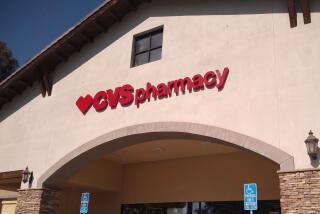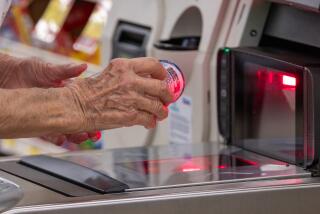Enter your PIN, get a prescription
- Share via
The lines at most pharmacies have gotten so frustratingly long in recent years that some people may want a Valium by the time they reach the counter.
But in this day of self-serve gas pumps and airline ticket dispensers, a solution could be at hand. Two companies have begun to install automated drug-dispensing machines, which look and operate like ATMs, in a few California stores. If customers take to the process, the machines may become increasingly commonplace.
To get their medication, consumers simply enter identifying information on a touch screen and swipe a credit card to pay for the prescription (there is no service fee). The medication -- already bagged -- slides down a chute. For now, the automated machines can dispense only refills, by order of the California State Board of Pharmacy.
“It’s well-recognized that there is a shortage of pharmacists and the whole system is being taxed,” says Bill Holmes, president and chief executive of Distributed Delivery Networks Corp., the San Marcos maker of one automated system. “But wherever there is a labor shortage, there is an automation solution.”
Few consumers would disagree the lines to pick up medications have grown. A dramatic upswing in drug prescriptions in the past decade along with a shortage of pharmacists has contributed to the gridlock. And, although more people today have prescription drug insurance, questions about coverage and co-pays can slow the pace of the pick-up line -- as have recent laws requiring pharmacists to offer consultations to patients receiving new prescriptions.
Pharmacies too have felt the pressures, hence their willingness to test the automated drug dispensers.
The state’s first automated dispensers were recently installed in stores in the San Diego area.
Distributed Delivery Networks has a machine at White Cross Drug Store in San Diego and will open another at a Kmart in Manhattan, N.Y., this summer. A competing company, Del Mar-based Asteres Inc., has installed its machine, called ScriptCenter, at a Longs drugstore in Del Mar and will soon add machines at Longs stores in San Diego and Walnut Creek. A Vons in San Diego will also carry a ScriptCenter later this year, as will a supermarket pharmacy in Reston, Va.
Asteres founder Linda Pinney says the idea of an automated drug dispenser occurred to her while waiting at her local pharmacy to pick up her monthly medication for attention-deficit hyperactivity disorder, a condition that can make concentration and extended patience difficult.
“I thought, ‘This is crazy; I have ADHD,’ ” says Pinney, who has a background working in healthcare automation technology. “I was determined that this was a problem that needed to be solved.”
Pharmacy experts agree that long waits are a problem. But they say it’s too early to know how helpful automated drug dispensers may be.
California Board of Pharmacy regulations do not specifically allow dispensing through automated systems, but stores carrying the machines have been granted waivers to test the technology, says Patricia Harris, executive officer of the Board of Pharmacy. (Mail-order drug delivery is covered by different regulations.) If the machines are successful, the board may vote to alter rules to permit their use.
“Long lines are a reality in many stores,” says Harris. “There are peak hours when it’s really difficult for patients, and it may be more convenient to use one of these delivery systems.”
The machines, which can hold hundreds of prescriptions, may prove to be of greatest value to consumers who want to pick up their prescriptions after the pharmacy has closed. In many chain drug and grocery stores, store hours are longer than the pharmacy hours.
“Many grocery stores are open 24 hours but the pharmacy closes at 7,” says Pinney. “Consumers are frustrated with that.”
Although pharmacists still fill the prescriptions and load the bags into the machine, automated dispensing may ease their workloads too, says Holmes.
But cutting out the human element worries some pharmacists, who have lobbied hard in recent years to increase their responsibilities for advising and educating consumers. In an April letter to the Board of Pharmacy, the California Pharmacists Assn. said the automated machines would reduce the opportunity for pharmacists and patients to interact. For example, consumers would not have the opportunity to ask questions about drug interactions or how to best use the medication.
“Convenience is not always the best thing,” says John A. Cronin, senior vice president of the California Pharmacists Assn. “What concerns us is the use of this kind of technology would tend to decrease the interaction between the pharmacist and the consumer.”
Cronin says his association has suggested that stores installing the technology submit a plan to the State Board of Pharmacy detailing how the machine could improve patient care.
“There is a place for these machines,” he says. “We’re not going to be able to suppress technological advances like this. But there needs to be a thought process about what the total impact will be on the consumer.”
Pinney points out that the machines will ask consumers if they want a consultation with a pharmacist. If the answer is yes, the consumer can step into a special line (if the pharmacy is open) to speak to the pharmacist at the counter.
The machines potentially could be configured with telephones or video teleconference screens for counseling by an off-site pharmacist. And they could provide consumers with a telephone number to call a pharmacist later.
The technology will not replace pharmacists, says Pinney. “What we are is a pharmacy clerk. We are absolutely not a pharmacist.”
Automated dispensing machines may even reduce the risk of some prescription errors, such as when the wrong prescription is handed to a patient, Holmes says. The machines will have several layers of security, such as requiring consumers to establish a user ID and password.
“Prescriptions going to consumers is like money going to consumers,” Pinney says. “The margin for error is zero.”
More to Read
Inside the business of entertainment
The Wide Shot brings you news, analysis and insights on everything from streaming wars to production — and what it all means for the future.
You may occasionally receive promotional content from the Los Angeles Times.










